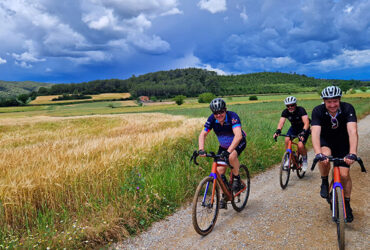Gravel bike trips & holidays
Go on an adventure with our Gravel stays!
Designed for versatility on all terrains, gravel cycling combines speed and comfort thanks to its wide tires and specific geometry for a unique off-road exploration experience. Gravel biking lets you push your limits and discover wild landscapes, while enjoying a stable, responsive ride. Join us on an adventure of freedom and discovery.
Gravel, back to basics
Gravel touring offers a unique adventure that combines the pleasure of cycling with the discovery of breathtaking landscapes. Whether on mountain trails, quiet country roads or rustic dirt roads, gravel biking allows cyclists to escape traditional roads and ride into uncharted territory, on efficient, playful sports bikes.
The history of Gravel
Gravel is the story of the very first bicycles, and in particular the first racing bikes. At the end of the 19th century, the main roads were dirt tracks – it wasn’t until the end of the First World War that the first tarmac roads were laid – and bikes were fitted with tubular tires wide enough to provide enough grip, but above all comfort, on these rough roads. After the war, as tarmac became more widespread and roads improved, road bikes became the norm, with ever smoother and thinner tires until the 2000s.
Today’s gravel may seem like a return to its origins, to the use of comfortable racing bikes on unpaved roads and tracks, but in fact it owes a great deal to the United States, where the country’s vast wilderness still offers many unpaved secondary roads. In the 1980s, pioneering cyclists were looking for ways to get off the beaten track and explore more remote territories. To do this, they adapted their traditional road bikes by fitting wider tires and adjusting the geometry for greater stability on dirt roads. This is how gravel biking began to emerge as a distinct practice, offering cyclists the freedom to explore varied terrain and spectacular natural landscapes. Within just a few years, gravel biking had grown in popularity in the USA, with the emergence of races and events dedicated to the discipline. And in the early 2010s, gravel biking began to gain ground in Europe, where it was enthusiastically welcomed by cycling enthusiasts looking for new adventures in the face of declining mountain biking and bikes not always suited to certain regions lacking in relief.
The arrival of gravel biking in Europe has been facilitated by a number of factors. Firstly, the diversity of the landscape offers ideal terrain, with its winding country roads, picturesque forest tracks and breathtaking mountain trails. What’s more, the growing popularity of bike packing, which can be defined as self-sufficient, light cycling tourism, and bike trips as real adventures, has helped to popularize gravel in Europe, with more and more cyclists looking to get out of traffic and discover new horizons. Today, gravel has become a must-do activity for many European cyclists, attracting enthusiasts from all walks of life in search of stimulating challenges and breathtaking scenery. Gravel events and races are organized all over Europe, offering participants the opportunity to test their skills and endurance over a variety of terrains and distances.
For the love of gravel
In the USA, a gravel road is generally an unpaved, unsealed road made up of compacted gravel or pebbles. These gravel roads can vary in surface and difficulty, from well-maintained, compacted roads to more rugged, bumpy paths. As a rule, gravel trails run through rural areas, farmland and forests, offering the chance to explore less developed, wilder environments. Gravel roads are often appreciated by cyclists for their less-travelled nature and quieter atmosphere than main roads.
Gravel, an exceptionally versatile bike
Gravel bikes are designed to handle a variety of surfaces and terrain. Inspired by road bikes, they have a few key differences:
- Gravel frames are made of aluminum, steel or carbon fiber for lightness and durability. Frame geometries are tuned for a more stable and comfortable ride over rough terrain, with wider steering angles and longer chainstays.
- Tires are wider than those on traditional road bikes, typically between 35 and 45 mm, for better grip and shock absorption on uneven surfaces.
- Disc brakes, offering superior stopping power and better modulation, essential for safe riding on varied terrain.
- Drivetrains offer both high gear ratios for speed on flat and smooth surfaces, and low gear ratios for climbing steep hills on mountain trails, or the lack of efficiency of certain sandy or muddy surfaces, or when you’re a little heavier in your bikepacking panniers.
This versatility and adaptability make gravel bikes ideal for exploring trails and roads less traveled, giving riders the freedom to go wherever they please and discover new horizons at their own pace.
Gravel, a real trend for the future of cycling
Gravel is often seen as the future of cycling for several compelling reasons. Firstly, gravel offers a more versatile and diverse experience than traditional road cycling. By allowing riders to explore a variety of surfaces, from country roads to mountain trails to dirt roads, gravel broadens riders’ horizons and opens up new possibilities for adventure. This versatility attracts a wide range of cyclists, from road bike enthusiasts to mountain bikers, contributing to the expansion and diversification of the cycling community.
Gravel offers a deeper connection with nature and the environment. By getting off the main roads and exploring wilder, more remote terrain, gravel cyclists have the opportunity to discover unspoilt natural landscapes and immerse themselves in unique natural environments.
What’s more, gravel embodies the spirit of adventure and exploration that characterizes cycling as a whole. By encouraging cyclists to step out of their comfort zone and take on new challenges, gravel encourages the development of skills and qualities such as resilience, determination and self-transcendence. This dimension of adventure and exploration helps to make cycling more exciting and rewarding, attracting new enthusiasts and strengthening passion.
Gravel also responds to the changing lifestyles and preferences of modern cyclists. With a growing demand for authentic and immersive experiences, as well as a preference for outdoor activities and discovery-oriented travel, gravel offers an attractive and stimulating alternative to traditional cycling practices.
An ally of simple pleasures
In addition to the physical challenges and breathtaking scenery, gravel riding is also synonymous with simple, authentic pleasures that enrich the cycling experience. One of these pleasures is often the traditional coffee break, a privileged moment when cyclists gather around a steaming cup of coffee to regain strength, swap stories and share tips on upcoming routes. Cafés such as Eat Sleep and Cycle in Girona, Spain, or Ta Grand-Mère à Vélo in Rennes, the capital of Brittany, are examples of emblematic places where cyclists regularly meet to enjoy a good cup of coffee and share their passion for gravel. Gravel riding is also a great way to meet and interact with the locals, sharing their culture and traditions with visitors. These chance encounters and spontaneous interactions add a valuable social and human dimension to the cycling experience, reinforcing the sense of connection with the people and places encountered along the way.

 Fit
Fit
